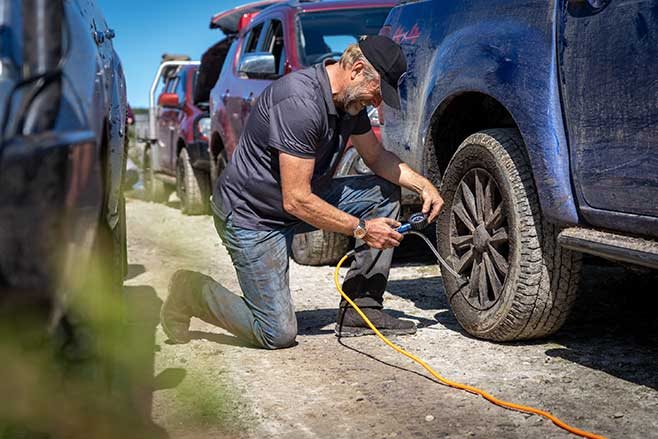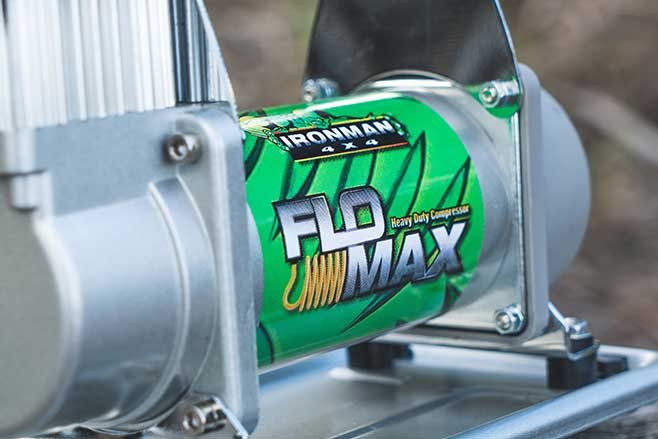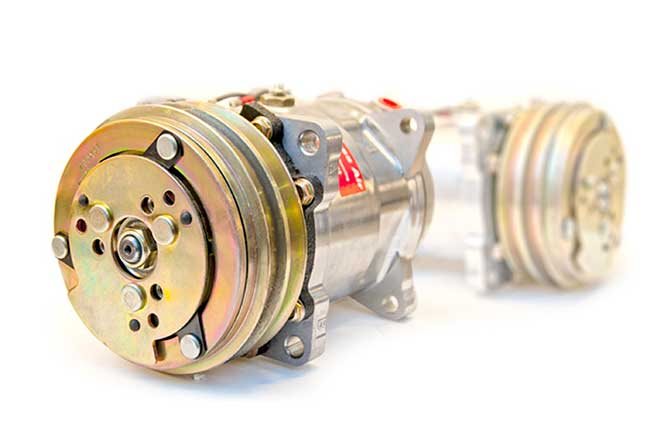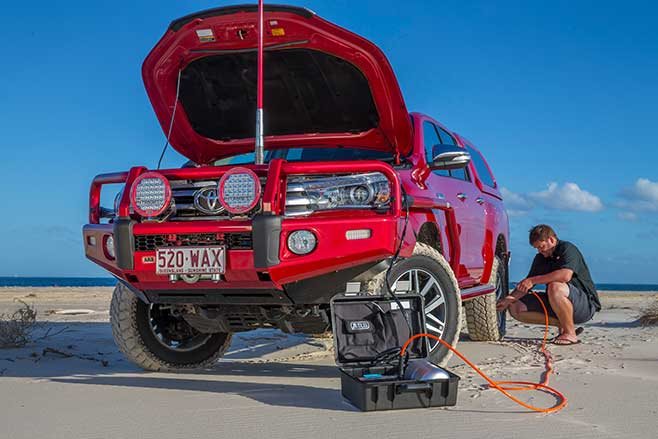Buyers Guide to Air Compressors

Know right to blow right when it comes to selecting the best air compressor.
A PORTABLE air compressor is an essential tool for the avid four-wheel driver.
It’s one of the most frequently used accessories, as situations constantly arise beyond the black stump that require a quick tyre-pressure change. They’re light-weight, easy to store, simple to use, and they won’t sting the hip pocket too much – plus, purchase the right attachment and you’ll be inflating your campsite mattress in next to no time.
Gone are the days of over-inflating the spare for emergencies, with a variety of different compressors now on the market. 12-volt electric compressors are by far the popular choice, but there are also engine-driven and battery-operated compressors to suit different needs.
So, if your adventures include traversing sand, dirt, mud, rocks and tarmac, there’s no reason to opt out when it comes to acquiring a portable air compressor.

WHY COMPRESSED AIR?
ALTERING TYRE pressures changes the size of a tyre’s footprint, with larger footprints improving traction in softer surfaces like sand and lowering the risk of getting bogged or stuck, and smaller footprints ideal on motorway runs.
To ensure tyre pressures are safely, securely, accurately and quickly modulated, it’s essential to have a no-nonsense tool that can be relied upon when the situation dictates.
Sure, pushing a twig on the valve needle may still be an effective way to drop tyre pressures down for a blast on the sand dunes, but these days, anyone who takes their off-roading seriously should be packing a portable air compressor to get the pressure back up.
“Air compressors are absolutely essential, as deflating tyres to tackle specific conditions will help get you out of tough places and with less stress on the vehicle,” ARB’s Shannon Alderwick said. “Having the reliability to inflate those tyres after driving at low pressures will ensure less tyre damage.”
Dip your toes into the air compressor market and you’ll notice there are both single- and twin-piston units available.
The single-piston offerings have been around the traps for yonks, with a tried-and-true formula of tyre inflation, albeit at a slow pace. Still, they’re lightweight, small in size and draw less power than their bigger siblings.

The twin-piston units can pump considerably more litres per minute than singles, yet come with a steeper sticker price and draw more power ... but you’ll be back on the tracks far sooner.
The majority of 4x4ers pack and run electric air compressors, with Ironman 4x4’s director of 4x4 products, Adam Craze, telling 4X4 Australia there’s good reason for this.
It’s this ease-of-use and versatility for remote-area use that appeals to the average punter, with electric compressors available in both fixed mountable and portable configurations.
“Mountable compressors come with a bracket system universal for many configurations ... for the most common places in a 4WD,” Alderwick said. “Using pneumatic lines provides the option to expand or change the system configuration with a range of fittings, joiners, and other components to suit any custom build.”
Another benefit of an electric air compressor is that you can reseat a tyre bead if it was to come away from the rim.
ENGINE-DRIVEN COMPRESSOR
SHOULD YOU require an even greater flow rate, there are engine-driven air compressors available, which, as the name implies, are mounted to a vehicle’s petrol or diesel engine, to generate an endless supply of compressed air.

One of the main benefits of an engine-drive air compressor is that they provide much greater output than the 12-volt units, are highly efficient and have the ability to stay cool and run for a much longer time. However, as they must be belt-driven, a common problem is finding space for the unit in the busy engine bays of modern vehicles.
Australian company Endless Air began producing compressors back in 1995. Its unit is a five-piston design that runs from a petrol or diesel engine through an electric clutch.
WHAT TO LOOK FOR?
BROWSING CATALOGUES for a new air compressor might be an overwhelming task, but there are a few key features to look for when buying one for that next 4x4 trip.
As always, it’s important to establish early on what your off-roading intentions are – will you spend your time blowing up the kids’ pool at a campsite? Or will you be lowering tyre pressures to reach that bucket-list campsite? If the latter, you’ll want a heavy-duty unit that’ll serve its purpose; if the former, well, just get a foot pump.
As well as researching flow rates, max current draws and duty cycles, there are a number of key cogs that comprise a quality compressor. We asked the experts at Ironman 4x4 and ARB to highlight the key features to look for when buying an air compressor.
“Reliability of components including wiring, connectors and switches to ensure it always works on any occasion,” Alderwick told us, with Craze adding: “Note how long is the hose, what is the duty cycle and how many amps does it draw. (Look at) litres per minute versus the size of your tyres. Also, size for storage. If you have a van, will it reach the camper or van tyres.”

If opting for a twin-piston compressor, keep an eye out for products with twin motors to power the pistons separately, providing further insurance if one piston goes bang.
“This ensures two motors can run independently at full performance while allowing the compressor to continue if there was ever a failure of one motor. The other motor then produces the same qualities as a single ARB compressor,” Alderwick said.
Another consideration – as with any 4x4 aftermarket purchase – is to research the brand you are buying from, specifically warranties, service network and parts availability.
Remember, you get what you pay for. Make an error in judgement and swipe the credit card for cheap and nasty inferior product, and it might come back to bite you ... or catch fire.
“Underrated, poor wiring quality presents a fire risk while in use due to the current requirements of a compressor,” Alderwick said. “Undersized fuse holders holding larger amp fuses result in melted wires and failure. (Plus) no over-pressure protection, which in warmer climates produces extreme temperatures, deteriorating seals and can cause fires.”
Alderwick said some companies have been known to publish fraudulent performance specs which could cause failure before reaching claimed limits.
Craze added: “Some products may look the same outside but internally are very different, like plastic gears or pistons.
Some hoses will melt or blow holes due to the heat, or small wiring that doesn’t cope with the power requirement.” Research, research, research!
FLOW RATE AND MAX CURRENT DRAW
YOU’RE BOUND to encounter the terms ‘Flow Rate’ and ‘Max Current Draw’ when hunting for a new compressor. Flow rate of an air compressor is the ‘generated litres per minute of the compressed air’, while max current draw is the highest number of amps a manufacturer would expect the compressor to consume under any standard operating conditions.

For example, look through the spec sheets and you might see a flow rate of 70lt/min and a max current draw of 65.5amp, this means it’ll have a flow rate of 70 litres per minute and a max current draw of 65.5 amps.
In relation to max current draw, Alderwick said: “A lower current draw will demand less of the vehicle’s electrical system, however lower currents will often reflect lower performance.”
DUTY CYCLE
PUT SIMPLY, a duty cycle of an air compressor describes how long it can run and how long it needs to rest. “Duty cycle is the amount of continuous running time a compressor has,” Alderwick said. “This must be referenced with an operating temperature, a pressure, and a time period.
“The duty cycle should be able to be run cyclically within those reference conditions indefinitely, without ever developing an unsafe level of heat.
“One hundred per cent duty cycle means a compressor can run continuously, but it still implies the requirement to stay within the reference conditions, and use outside of those conditions would lower the published duty cycle.”
Look for a duty cycle which allows you to inflate all of your tyres in normal conditions, without having to overwork or rest the compressor.
See our Compressors Here.
Article Credit - WhichCar

